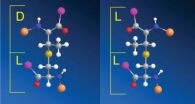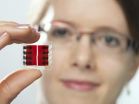(Press-News.org) The strong binding of gold on electronically modified calcium oxide can now be understood in detail. In a computational study, researchers Jenni Andersin, Janne Nevalaita, Karoliina Honkala and Hannu Häkkinen at the University of Jyväskylä Nanoscience Center have shown how redox chemistry entirely determines the adsorption strength of gold on the modified oxide where one metal atom is replaced with molybdenum. The study was funded by the Academy of Finland.
The research team applied the so-called Born-Haber cycle to analyse how different terms contribute to adsorption energy. The calculations were done at the supercomputers of the CSC – IT Center of Science by employing quantum mechanical simulation methods.
In the oxide lattice, the molybdenum atom donates two electrons into the oxide. When a gold atom adsorbs on the oxide surface, a redox reaction takes place. In this process, a third electron transferred by the dopant is gained by gold, and energy is released. By varying the dopant among several transition metal atoms, the researchers found that the amount of energy released linearly correlates with the ability of the dopant to give an electron. The trend can be used to estimate how much a guest atom stabilises gold adsorption without calculating the adsorption energy.
The research results are important for understanding catalyst-support interaction. The results fully support the experimental observation where gold nanoparticles have been seen to form flat structures over modified calcium oxide surfaces. A similar Born-Haber cycle, as applied in this study, can also be employed to analyse oxide-catalysed chemical reactions that follow the redox mechanism.
Catalysts are commonly used by industry, for instance, in the production of fuels, plastics, fertilisers and other similar products. Metal oxide surfaces are widely used as support materials for metal catalysts particles. The binding properties and shape of metal nanoparticles sensitively depend on the interaction between the support and the catalyst. By tuning this interaction, it is possible to affect the number and properties of catalytically active sites, or even create new sites. One way to modify the interaction is to dope the oxide with guest metal atoms that can donate extra electrons into a material.
INFORMATION:
The results of the research team were published in December 2012 in the prestigious chemistry journal Angewandte Chemie: "The Redox Chemistry of Gold with High-Valence Doped Calcium Oxide" (http://onlinelibrary.wiley.com/doi/10.1002/anie.201208443/abstract).
More information:
Docent Karoliina Honkala
University of Jyväskylä, Department of Chemistry, Nanoscience Center
tel. +358 40 805 3686
vfirstname.lastname(at)jyu.fi
Academy of Finland Communications
Communications Specialist Leena Vähäkylä
tel. +358 29 533 5139
firstname.lastname(at)aka.fi
New information on binding gold particles over metal oxide surfaces
2013-01-22
ELSE PRESS RELEASES FROM THIS DATE:
The Nurse Practitioner marks 25th Annual Legislative Update
2013-01-22
Philadelphia, Pa. (January 22, 2013) – The most comprehensive review of new legal and regulatory issues affecting advanced nursing practice across the United States is now available in the "25th Annual Legislative Update," presented exclusively by The Nurse Practitioner: The American Journal of Primary Healthcare. The Nurse Practitioner is published by Lippincott Williams & Wilkins, a part of Wolters Kluwer Health.
Compiled by Susanne J. Phillips, MSN, FNP-BC, the annual supplement presents a comprehensive review of the legislative proceedings, bills, and laws pertaining ...
South Americans want policy makers to put ethics above price
2013-01-22
Researchers at Royal Holloway university have found that Brazilians and Chileans want the state to buy on social and environmental criteria, not just on price.
Based on this pioneering research, researchers from Royal Holloway have been invited to be the first academics to join the UN Environmental Programme's global Sustainable Public Procurement Initiative and attend its meeting in Paris this week.
The Choices Project is a collaboration between Royal Holloway, the Universidade Federal do Rio de Janeiro and Universidad Diego Portales. The project team also involves ...
Mayo Clinic expert suggests proper techniques for newborn bathing and skin care basics
2013-01-22
ROCHESTER, Minn. -- Bathing a tiny newborn can be an exciting experience for parents, but it can also be intimidating. Newborns are small and vulnerable, slippery when wet, and the products marketed for their delicate skin can leave parents with abundant choices. As newborns are welcomed into the world, their skin needs to adapt to the new environmental changes around them. It's important for parents to understand proper bathing techniques and the appropriate skin care needed for their little one.
Pediatric dermatologist Dawn Davis, M.D., of Mayo Clinic Children's Center ...
Study: Odd biochemistry yields lethal bacterial protein
2013-01-22
CHAMPAIGN, Ill. — While working out the structure of a cell-killing protein produced by some strains of the bacterium Enterococcus faecalis, researchers stumbled on a bit of unusual biochemistry. They found that a single enzyme helps form distinctly different, three-dimensional ring structures in the protein, one of which had never been observed before.
The new findings, reported in Nature Chemical Biology, should help scientists find new ways to target the enterococcal cytolysin protein, a "virulence factor that is associated with acute infection in humans," said University ...
Scientists find gene interactions that make cocaine abuse death 8 times more likely
2013-01-22
COLUMBUS, Ohio – Scientists have identified genetic circumstances under which common mutations on two genes interact in the presence of cocaine to produce a nearly eight-fold increased risk of death as a result of abusing the drug.
An estimated one in three whites who died of cocaine exposure is a carrier of variants that make cocaine abuse particularly deadly.
The variants are found in two genes that affect how dopamine modulates brain activity. Dopamine is a chemical messenger vital to the regular function of the central nervous system, and cocaine is known to block ...
Tiny fossils hold answers to big questions on climate change
2013-01-22
The western Antarctic Peninsula is one of the fastest warming regions on the planet, and the fastest warming part of the Southern Hemisphere.
Scientists have debated the causes of this warming, particularly in light of recent instrumental records of both atmospheric and oceanic warming from the region. As the atmosphere and ocean warm, so the ice sheet (holding an equivalent of 5 metres of global sea level rise, locked up in ice) becomes vulnerable to collapse.
Now research led by Cardiff University published in Nature Geoscience has used a unique 12,000 year long ...
New study examines on/off relationships and 'sex with an ex' among teenagers and young adults
2013-01-22
Los Angeles, CA (January 22, 2013)- A new study finds that nearly half of older teenagers and young adults break up and get back together with previous dating partners and over half of this group have sex as part of the reconciliation process. This study was recently published in the Journal of Adolescent Research, a SAGE journal.
Researchers Sarah Halpern-Meekin, Wendy Manning, Peggy Giordano and Monica Longmore studied data on 792 daters and cohabiters ages 17 to 24, also known as "emerging adults." The researchers studied two relationship patterns specifically – reconciliation ...
New drug protects against side effects of chemotherapy
2013-01-22
A drug developed at Linköping University in Sweden protects against the side effects of cancer treatments while strengthening the effects on the tumour. An international drug evaluation is now starting up on a larger group of patients.
The results of the studies with the compound, known as calmangafodipir, were published in the latest issue of the cancer journal Translational Oncology with Professor Rolf G. G. Andersson as the main author.
The research was initiated on a substance called mangafodipir, which was used as a contrast media in magnetic resonance scans. But ...
Image sensors out of a spray can
2013-01-22
This press release is available in German. Image sensors are at the core of every digital camera. Before a snapshot appears on the display, the sensors first convert the light from the lens to electrical signals. The image processor then uses these to create the final photo.
Many compact and cellphone cameras contain silicon-based image sensors produced using CMOS (complementary metal oxide semiconductor) technology. Prof. Paolo Lugli and Dr. Daniela Baierl from TUM have developed a cost-effective process to improve the performance of these CMOS sensors. Their approach ...
Public acceptance of climate change affected by word usage
2013-01-22
Public acceptance of climate change's reality may have been influenced by the rate at which words moved from scientific journals into the mainstream, according to anthropologist Michael O'Brien, dean of the College of Arts and Science at the University of Missouri. A recent study of word usage in popular literature by O'Brien and his colleagues documented how the usage of certain words related to climate change has risen and fallen over the past two centuries. Understanding how word usage affects public acceptance of science could lead to better science communication and ...


